Monday, July 11, 2016
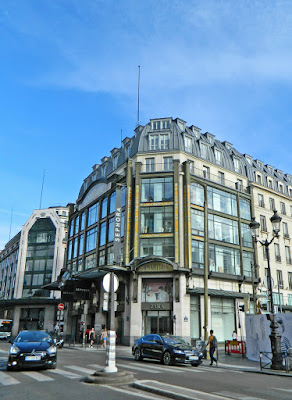 |
La Samaritaine, former department store
(1905-1910) by Frantz Jourdain in Art Nouveau style |
 |
A second building of La Samaritaine across the street,
(1904-1907) by François Gourdin, updated in 1922-1928
with Art Deco elements |
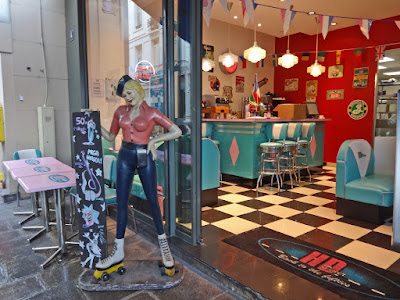 |
| HD (Happy Days) '50s Diner (KSS) |
 |
| L'Express Bar for breakfast |
After breakfast of coffee and hot chocolate, and croissants, we walked down Rue de Rivoli towards Place de la Concorde.
 |
Église Réformée de l'Oratoire du Louvre/Reformed Church of
the Oratory of the Louvre (1625-1745 as a church for the Oratory
of St Philip Neri; was given to the Protestants by Napoléon in 1811) |
 |
The result of a viral campaign after 11/2015 bombings in Paris,
submitted Twitter photos were displayed on this sculpture |
 |
Another Métro station entrance designed
by Henri Guimard in Art Nouveau style |
 |
Hotel Regina entrance in the arcades along
Rue de Rivoli, with tile mosaics |
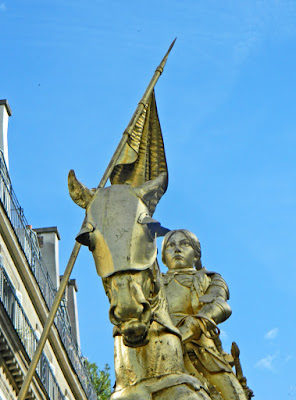 |
Gilded bronze statue of Jeanne d'Arc (1874)
by Emmanuel Frémiet, located near the site
where Joan of Arc was wounded during her
failed attempt to take Paris |
 |
| Leo Tolstoy lived here in 1857 |
 |
| Front of Hotel Meurice |
 |
| Tile mosaic entrance of Hotel Meurice |
 |
| Rue de Rivoli arcades |
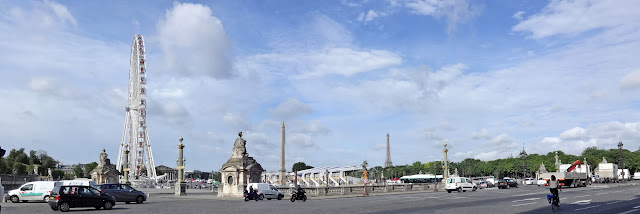 |
| Place de la Concorde (KSS) |
Place de la Concorde started as Place Louis XV with his statue (1763 by Jean-Pierre Cortot) in the center. During the French revolution, the statue was destroyed, and replaced by the guillotine (1793) in Place de la Révolution. In two-and-a-half years, 2,780 people lost their heads.
In 1795 it was renamed Place de la Concorde, then in 1814 it was back to being Place Louis XV. In 1826 it became Place Louis XVI, who was guillotined here along with his wife, Marie Antoinette. After the July Revolution of 1830 the name returned to Place de la Concorde. It is the end point of the Bastille Day parades, and of the Tour de France.
There are eight statues (1836) personifying French cities by Jean -Pierre Cortot, Pierre Petitot, Louis-Denis Cailloutte, and James Pradier.
 |
| Strasbourg by James Pradier |
 |
| Rouen by Jean-Pierre Cortot |
 |
| Lyon by Pierre Petitot |
There are two fountains (1840) by Jacques-Ignace Hittorff.
 |
| Rhône and Rhine: Rivers Fountain |
 |
| Atlantic and Mediterranean: Seas Fountain |
 |
The gold-leaf-capped Luxor Obelisk (c. 1400 BCE),
one of two given to France in 1832 by Muhammed Ali,
Khedive of Egypt, one arriving in France in 1833
and erected in 1836 by King Louis-Phlippe |
Only one of the obelisks was transported to France; the other was "returned" to Egypt by President Mitterand in 1981.
 |
The Bastille Day Parade traditionally ends with a paratrooper carrying
the colors of the French flag landing on this 'x' directly in front
of the French President's stand |
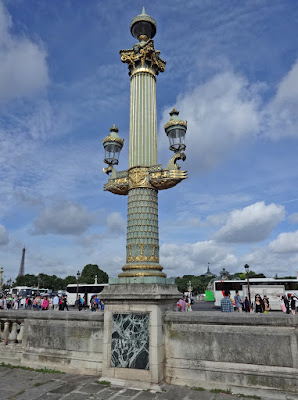 |
| Candelabra lamp post (KSS) |
 |
| La Grand Roue/Big Wheel (KSS) |
A Ferris wheel was first erected in Place de la Concorde for the 2000 Millennium celebration by Marcel Campion, and that wheel has traveled around the world. A Big Wheel has been set up annually for the Christmas market here, and this year it will remain in operation through the summer due to the European Soccer Championship. The cars are decorated with faces painted in the colors of the flags of the countries participating in the championship.
Took a shortcut through the
Jardin des Tuileries/Tuileries Garden, established in 1564. In 1664, Louis XIV commissioned André le Nôtre to redesign the whole garden. It was opened to the public in 1667.
 |
| André le Nôtre Memorial (KSS) |
Later, Napoléon III made much of the garden private, and had l'Orangerie (1852, to house orange trees during the winter) and the Jeu de Paume (1861, houses courts for the game of jeu de paume, a precursor of tennis) constructed.
 |
| Orange trees |
 |
| Garden plot filled with lavender |
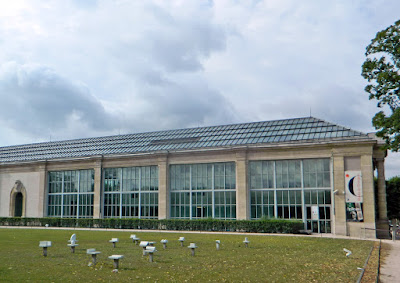 |
l'Orangerie with the art installation called Grand Commandment Blanc
(1985) by Alain Kirili |
In 1921, it was decided to use the Jeu de Paume and l'Orangerie for art exhibitions. Claude Monet signed a contract in 1922 to donate some of his works as a monument to the end of the Great War. Architect Camille Lefèvre designed the renovations to include two oval rooms to house the decorative panels. After Monet's death in 1926, the paintings were placed in the museum and opened to the public in 1927. The cycle of eight paintings is known as
Les Nymphéas/The Water Lilies.
 |
| The Clouds (1920-1926) (KSS) |
 |
| Setting Sun (1920-1926) (KSS) |
Since 1965, the downstairs of l'Orangerie has housed the Walter-Guillaume Collection. Paul Guillaume was an art dealer, who also dealt in African art. When he died, his wife Domenica married Jean Walter, and continued collecting. There are 27 paintings by Auguste Renoir.
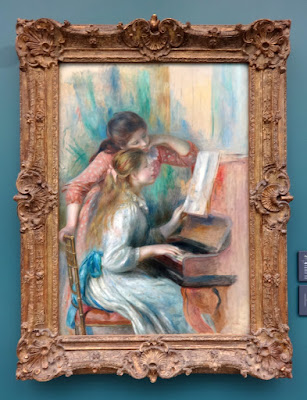 |
| Jeunes filles au piano/Young Girls at the Piano (1892) (KSS) |
Plus 14 works by Paul Cézanne.
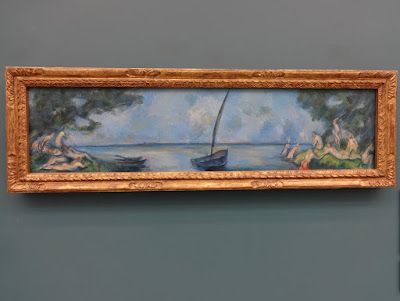 |
| La Barque et les Baigneurs/The Boat and Bathers (c. 1890) (KSS) |
There was an assortment of other Impressionist and Post-Impressionist paintings.
 |
| Argenteuil (1857( by Claude Monet (KSS) |
 |
Dindon et Tomates/Turkey and Tomatoes
(c. 1923-1924) by Chaïm Soutine, in Expressionist style |
 |
Femme au Tamborin/Female with tambourine (1925)
by Pablo Picasso, experimenting with Cubism (KSS) |
 |
Le Boudoir (1921) by Henri Matisse, shows
the transition from Cubism to his paler
Riviera tones, and perspective is
thrown out the window (KSS) |
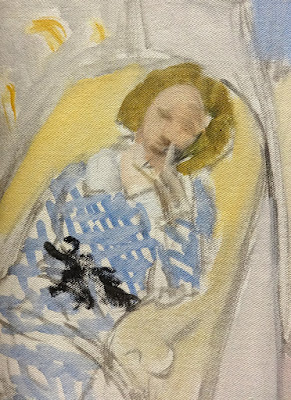 |
| The young girl appears to be picking her nose (KSS) |
 |
Antonia (c. 1915) by Amedeo Modigliani;
his style was influenced by primitive masks |
 |
Portrait de Mademoiselle Chanel (1923) by
Marie Laurencin, in pastels |
 |
Église St-Pierre/St Peter Church (c. 1914) by
Maurice Utrillo of Montmartre, during his white period (KSS) |
 |
| A model of Paul Guillaume's apartment |
We had lunch at the museum café, sharing a ham and cheese on baguette sandwich.
Next: Sainte-Chapelle.








































No comments:
Post a Comment